
|
Astronomy Picture Of the Day (APOD)
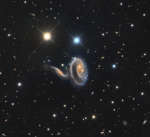 Peculiar Galaxies of Arp 273
Peculiar Galaxies of Arp 273
9.01.2025
The colorful, spiky stars are in the foreground of this image taken with a small telescope on planet Earth. They lie well within our own Milky Way Galaxy. But the two eye-catching galaxies in the frame lie far beyond the Milky Way, at a distance of over 300 million light-years.
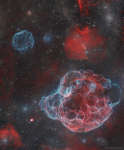 APOD: 2025 January 8 B Supernova Remnants Big and Small
APOD: 2025 January 8 B Supernova Remnants Big and Small
8.01.2025
What happens after a star explodes? A huge fireball of hot gas shoots out in all directions. When this gas slams into the existing interstellar medium, it heats up so much it glows. Two different supernova remnants (SNRs) are visible in the featured image, taken at the Oukacmeden Observatory in Morocco.
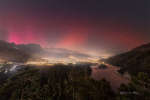 APOD: 2025 January 7 B A New Years Aurora and SAR Arc
APOD: 2025 January 7 B A New Years Aurora and SAR Arc
7.01.2025
It was a new year, and the sky was doubly red. The new year meant that the Earth had returned to its usual place in its orbit on January 1, a place a few days before its closest approach to the Sun.
 APOD: 2025 January 6 B Colliding Spiral Galaxies from Webb and Hubble
APOD: 2025 January 6 B Colliding Spiral Galaxies from Webb and Hubble
6.01.2025
Billions of years from now, only one of these two galaxies will remain. Until then, spiral galaxies NGC 2207 and IC 2163 will slowly pull each other apart, creating tides of matter, sheets of shocked gas, lanes of dark dust, bursts of star formation, and streams of cast-away stars.
 APOD: 2025 January 5 B Rocket Launch as Seen from the International Space Station
APOD: 2025 January 5 B Rocket Launch as Seen from the International Space Station
5.01.2025
Have you ever seen a rocket launch -- from space? A close inspection of the featured time-lapse video will reveal a rocket rising to Earth orbit as seen from the International Space Station (ISS).
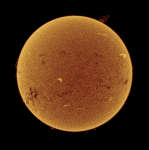 Welcome to Perihelion
Welcome to Perihelion
4.01.2025
Earth's orbit around the Sun is not a circle, it's an ellipse. The point along its elliptical orbit where our fair planet is closest to the Sun is called perihelion. This year perihelion is today, January 4, at 13:28 UTC, with the Earth about 147 million kilometers from the Sun.
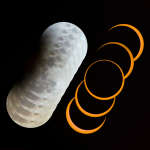 Eclipse Pair
Eclipse Pair
3.01.2025
Eclipses tend to come in pairs. Twice a year, during an eclipse season that lasts about 34 days, Sun, Moon, and Earth can nearly align. Then the full and new phases of the Moon, separated by just over 14 days, create a lunar and a solar eclipse.
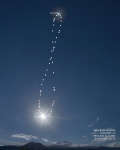 Solar Analemma 2024
Solar Analemma 2024
2.01.2025
Recorded during 2024, this year-spanning series of images reveals a pattern in the seasonal drift of the Sun's daily motion through planet Earth's sky. Known to some as an analemma, the figure-eight curve was captured in exposures taken only at 1pm local time on clear days from Kayseri, Turkiye.
 APOD: 2025 January 1 B Alpha Centauri: The Closest Star System
APOD: 2025 January 1 B Alpha Centauri: The Closest Star System
1.01.2025
The closest star system to the Sun is the Alpha Centauri system. Of the three stars in the system, the dimmest -- called Proxima Centauri -- is actually the nearest star. The bright stars Alpha Centauri...
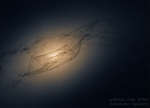 APOD: 2024 December 31 B The Twisted Disk of NGC 4753
APOD: 2024 December 31 B The Twisted Disk of NGC 4753
31.12.2024
What do you think this is? HereBs a clue: it's bigger than a bread box. Much bigger. The answer is that pictured NGC 4753 is a twisted disk galaxy, where unusual dark dust filaments provide clues about its history.
|
January February March April May June July August September October November December |
|||||||||||||||||||||||||||||||||||||||||||||||||